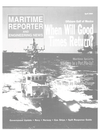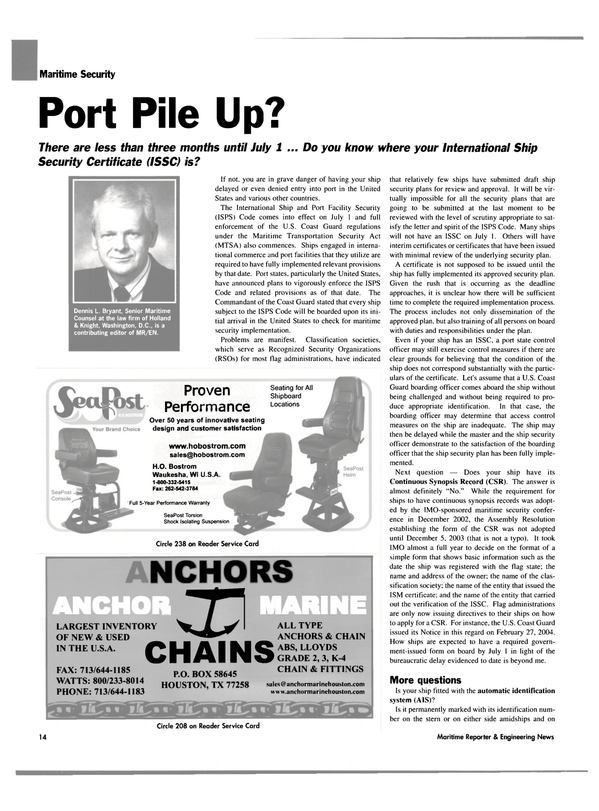
Port Pile Up?
There are less than three months until July 1 ... Do you know where your International Ship Security Certificate (ISSC) is?
If not, you are in grave danger of having your ship delayed or even denied entry into port in the United States and various other countries.
The International Ship and Port Facility Security (ISPS) Code comes into effect on July 1 and full enforcement of the U.S. Coast Guard regulations under the Maritime Transportation Security Act (MTSA) also commences. Ships engaged in international commerce and port facilities that they utilize are required to have fully implemented relevant provisions by that date. Port states, particularly the United States, have announced plans to vigorously enforce the ISPS Code and related provisions as of that date. The Commandant of the Coast Guard stated that every ship subject to the ISPS Code will be boarded upon its initial arrival in the United States to check for maritime security implementation.
Problems are manifest. Classification societies, which serve as Recognized Security Organizations (RSOs) for most flag administrations, have indicated that relatively few ships have submitted draft ship security plans for review and approval. It will be virtually impossible for all the security plans that are going to be submitted at the last moment to be reviewed with the level of scrutiny appropriate to satisfy the letter and spirit of the ISPS Code. Many ships will not have an ISSC on July 1. Others will have interim certificates or certificates that have been issued with minimal review of the underlying security plan.
A certificate is not supposed to be issued until the ship has fully implemented its approved security plan.
Given the rush that is occurring as the deadline approaches, it is unclear how there will be sufficient time to complete the required implementation process.
The process includes not only dissemination of the approved plan, but also training of all persons on board with duties and responsibilities under the plan.
Even if your ship has an ISSC, a port state control officer may still exercise control measures if there are clear grounds for believing that the condition of the ship does not correspond substantially with the particulars of the certificate. Let's assume that a U.S. Coast Guard boarding officer comes aboard the ship without being challenged and without being required to produce appropriate identification. In that case, the boarding officer may determine that access control measures on the ship are inadequate. The ship may then be delayed while the master and the ship security officer demonstrate to the satisfaction of the boarding officer that the ship security plan has been fully implemented.
Next question — Does your ship have its Continuous Synopsis Record (CSR). The answer is almost definitely "No." While the requirement for ships to have continuous synopsis records was adopted by the IMO-sponsored maritime security conference in December 2002, the Assembly Resolution establishing the form of the CSR was not adopted until December 5, 2003 (that is not a typo). It took IMO almost a full year to decide on the format of a simple form that shows basic information such as the date the ship was registered with the flag state; the name and address of the owner; the name of the classification society: the name of the entity that issued the ISM certificate; and the name of the entity that carried out the verification of the ISSC. Flag administrations are only now issuing directives to their ships on how to apply for a CSR. For instance, the U.S. Coast Guard issued its Notice in this regard on February 27, 2004.
How ships are expected to have a required government- issued form on board by July I in light of the bureaucratic delay evidenced to date is beyond me.
More questions Is your ship fitted with the automatic identification system (AIS)?
Is it permanently marked with its identification number on the stern or on either side amidships and on either one of the end transverse bulkheads in the machinery spaces or in one of the hatchways or in the pump-room (on a tanker) or on one of the end transverse bulkheads of the ro-ro spaces (on a ro-ro ship)?
Is it fitted with a Ship Security Alert System (SSAS — basically a silent alarm that notifies a competent authority ashore that a security incident has occurred on the ship)?
AIS originated as a safety device, intended to reduce the risk of collision by allowing ships to identify each other by name, course, and speed on the radar screen.
It has been converted into a security instrument, but numerous problems are inherent in this rapid transition.
Few coastal and port nations, including the United States, have installed shoreside transceivers to make use of the information that ships will be continuously transmitting. In the United States, the Federal Communications Commission (FCC) sold the frequency spectrum on which AIS is intended to function.
This auction, which occurred some years ago, was approved by the U.S. Coast Guard, which never anticipated this turn of events.
With regard to the ship security alert system, few nations have designated the competent authority that is to receive the alarm signal. Fewer still have issued directives on what is to be done when and if such an alarm signal is received. Fewer still have a creditable capability to take action to address the security incident on the ship that transmitted the alarm signal.
Additionally, some of the satellites that were expected to receive and re-transmit the alert signal can't do the job. You should check carefully to determine whether your signal can get through and what will be done with the alarm signal when it does arrive.
Port facilities don't get off the hook. Many of the same requirements apply to them, and there are indications that they are no further along in compliance with the ISPS Code than are ships. What happens if, on or after July 1, your ship calls at a port facility that is not in compliance with the ISPS Code? Such an event may constitute a security incident that leads to increased scrutiny of your ship when it arrives at a future port.
While ports (as differentiated from individual facilities at ports) are not specifically addressed by the ISPS Code, they are covered by the MTSA. The European Union is also commencing the process to consider port security on a holistic basis. In addition, U.S. law requires the Coast Guard to assess the security situation at foreign ports. Ports that are found to have inadequate security will be placed on a black list. Ships arriving in the U.S. from those ports will be subject to increased scrutiny and may be barred entry.
An issue the legislators and regulators fail to consider is cost allocation. Who is going to and who should bear the costs when a ship is delayed due to security issues? Does the answer change if the cause of the delay is that a prior charterer ordered the ship to a port with inadequate security? Does the answer change again if the cause of the delay is cargo-related? The maritime community needs to review these issues carefully now, rather than wait for the inevitable.
Anyone who thinks the U.S. Coast Guard is not going to take strong enforcement measures regarding maritime security should consider the freight vessel BBC CHINA. This vessel arrived in Honolulu in early February 2004 having submitted its notice of arrival less than 96 hours in advance. The Coast Guard delayed the ship for several days while it thoroughly reviewed the vessel, crew, and cargo.
In light of the above, there seems little doubt that things are going to prove extremely interesting during July. One should expect delays and backups as everyone plays catch-up trying to come to grips with this new maritime security regime. The only way to avoid a port pileup is for everyone to work together in good faith.
Read Port Pile Up? in Pdf, Flash or Html5 edition of April 2004 Maritime Reporter
Other stories from April 2004 issue
Content
- Rocknes Successfully Parbuckled page: 8
- Galtex Pilots Order New Jet Boat page: 9
- Meyer Werft Delivers New RoRo-Cruise Ferry page: 10
- Bollinger Launches Innovative OSV Hull page: 12
- Port Pile Up? page: 14
- U.S. Manifest Presentation Requirements page: 17
- Terrorist and Bogus Marine Credentials page: 23
- Rig Demand in the Doldrums page: 24
- The Future is Now page: 30
- SNAME: Investing in the Future page: 32
- Offshore Prospects Keep Bollinger Busy page: 34
- Bollinger Delivers ATB for Bouchard page: 34
- ShipConstructor 2 0 0 4 used for M/V Cheramie BoTruc 38 page: 36
- Stability Software for Semi Submersible Rigs page: 38
- VT Halter: King has Company Back on Track page: 40
- Teekay Enters LNG With Tapias Acquisition page: 42
- Drewry Forecasts Strong LNG Growth page: 42
- ChevronTexaco to Operate New LNG Carrier page: 43
- ABS Addresses Tech Concerns page: 44
- Dual-fuel Diesel Engines for LNG Carriers page: 46
- Graig Extends Cooperation With Vinashin page: 49
- Teekay Seeks to Grow Suezmax Fleet page: 50
- SMT: Safe and Cost Effective Mooring page: 50
- Wilh. Wilhelmsen ASA: Profits to Roll Through 2004 page: 52
- Farstad: North Sea Utilization Rates Down page: 54
- ConCat Survey Cat Trolls for Buyers page: 55
- Berge Boston Gets New Ship Security System page: 56
- Kongsberg Maritime: United, Diverse page: 57
- The Rules are About to Change page: 60
- Cool Technology page: 62
- Advanced Joint Health Service Support and Sea Basing Concept page: 64


